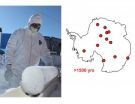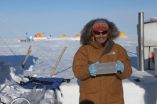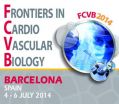(Press-News.org) RENO – A team of scientists led by Michael Sigl and Joe McConnell of Nevada's Desert Research Institute (DRI) has completed the most accurate and precise reconstruction to date of historic volcanic sulfate emissions in the Southern Hemisphere.
The new record, described in a manuscript published today in the online edition of Nature Climate Change, is derived from a large number of individual ice cores collected at various locations across Antarctica and is the first annually resolved record extending through the Common Era (the last 2,000 years of human history).
"This record provides the basis for a dramatic improvement in existing reconstructions of volcanic emissions during recent centuries and millennia," said the report's lead author Michael Sigl, a postdoctoral fellow and specialist in DRI's unique ultra-trace ice core analytical laboratory, located on the Institute's campus in Reno, Nevada.
These reconstructions are critical to accurate model simulations used to assess past natural and anthropogenic climate forcing. Such model simulations underpin environmental policy decisions including those aimed at regulating greenhouse gas and aerosol emissions to mitigate projected global warming.
Powerful volcanic eruptions are one of the most significant causes of climate variability in the past because of the large amounts of sulfur dioxide they emit, leading to formation of microscopic particles known as volcanic sulfate aerosols. These aerosols reflect more of the sun's radiation back to space, cooling the Earth. Past volcanic events are measured through sulfate deposition records found in ice cores and have been linked to short-term global and regional cooling.
This effort brought together the most extensive array of ice core sulfate data in the world, including the West Antarctic Ice Sheet (WAIS) Divide ice core – arguably the most detailed record of volcanic sulfate in the Southern Hemisphere. In total, the study incorporated 26 precisely synchronized ice core records collected in an array of 19 sites from across Antarctica.
"This work is the culmination of more than a decade of collaborative ice core collection and analysis in our lab here at DRI," said Joe McConnell, a DRI research professor who developed the continuous-flow analysis system used to analyze the ice cores.
McConnell, a member of several research teams that collected the cores (including the 2007-2009 Norwegian-American Scientific Traverse of East Antarctica and the WAIS Divide project that reached a depth of 3,405 meters in 2011), added, "The new record identifies 116 individual volcanic events during the last 2000 years."
"Our new record completes the period from years 1 to 500 AD, for which there were no reconstructions previously, and significantly improves the record for years 500 to 1500 AD," Sigl added. This new record also builds on DRI's previous work as part of the international Past Global Changes (PAGES) effort to help reconstruct an accurate 2,000-year-long global temperature for individual continents.
This study involved collaborating researchers from the United States, Japan, Germany, Norway, Australia, and Italy. International collaborators contributed ice core samples for analysis at DRI as well as ice core measurements and climate modeling.
According to Yuko Motizuki from RIKEN (Japan's largest comprehensive research institution), "The collaboration between DRI, National Institute of Polar Research (NIPR), and RIKEN just started in the last year, and we were very happy to be able to use the two newly obtained ice core records taken from Dome Fuji, where the volcanic signals are clearly visible. This is because precipitation on the site mainly contains stratospheric components." Dr. Motizuki analyzed the samples collected by the Japanese Antarctic Research Expedition.
Simulations of volcanic sulfate transport performed with a coupled aerosol-climate model were compared to the ice core observations and used to investigate spatial patterns of sulfate deposition to Antarctica.
"Both observations and model results show that not all eruptions lead to the same spatial pattern of sulfate deposition," said Matthew Toohey from the German institute GEOMAR Helmholtz Centre for Ocean Research Kiel. He added, "Spatial variability in sulfate deposition means that the accuracy of volcanic sulfate reconstructions depends strongly on having a sufficient number of ice core records from as many different regions of Antarctica as possible."
With such an accurately synchronized and robust array, Sigl and his colleagues were able to revise reconstructions of past volcanic aerosol loading that are widely used today in climate model simulations. Most notably, the research found that the two largest volcanic eruptions in recent Earth history (Samalas in 1257 and Kuwae in 1458) deposited 30 to 35 percent less sulfate in Antarctica, suggesting that these events had a weaker cooling effect on global climate than previously thought.
INFORMATION:
This research was funded through the U.S. National Science Foundation grants 0538416, 0538427, 0839093, 0632031, and 0739780; the Funding Program for Next Generation World-Leading Researchers (NEXT Program, Grant Number GR098) supported by the Cabinet Office, Government of Japan and the Japan Society for the Promotion of Science; and the Federal Ministry for Education and Research in Germany (BMBF) through the research program 'MiKlip.'
About the Desert Research Institute: DRI, the nonprofit research campus of the Nevada System of Higher Education, strives to be the world leader in environmental sciences through the application of knowledge and technologies to improve people's lives throughout Nevada and the world. All DRI news releases are available at http://news.dri.edu/.
Rewriting the history of volcanic forcing during the past 2,000 years
A year-by-year record of volcanic eruptions from a comprehensive Antarctic ice core array
2014-07-06
ELSE PRESS RELEASES FROM THIS DATE:
Global toolkit to diagnose menopause
2014-07-06
Created at Monash University, the world's first toolkit is designed for GPs to use with women from the age of 40. Thought to be the first of its kind, researchers say the toolkit has the potential to help manage menopausal conditions for women globally.
The Practitioner Toolkit for Managing the Menopause, which includes a diagnostic tool, as well as a compendium of approved hormone therapies, is published today in the journal, Climacteric.
Led by Professor Susan Davis, the research team from the School of Public Health and Preventative Medicine, combined existing research ...
The Lancet: Sierra Leone researchers call for improved health surveillance and communication around Ebola crisis
2014-07-05
Researchers working in Sierra Leone today [Saturday 5 July] suggest priority actions needed to tackle the ongoing Ebola crisis in West Africa. In a letter to The Lancet, the researchers call for improvements in access to diagnostic technologies and health-care resources, as well as improved disease surveillance and health communication.
At present, there is little incentive for patients to seek professional diagnosis of suspected Ebola, say the authors, with most people with febrile (fever-causing) illnesses in Sierra Leone treated at home, and the true extent of the ...
The Lancet: New trial suggests cheaper drugs for common heart attack procedure could improve outcomes and save health budgets millions
2014-07-05
A new study published in The Lancet compares outcomes for two drugs used to prevent blood clot formation during emergency heart attack treatment. The study suggests that use of one of the drugs, heparin, could result in improved outcomes (such as a reduced rate of repeat heart attacks), compared to the other drug tested, bivalirudin, which is in widespread use in high-income countries, and is around 400 times more expensive than heparin.
The results of the HEAT-PPCI trial suggest that systematic use of heparin rather than bivalirudin after primary percutaneous coronary ...
Association found between high cholesterol and breast cancer
2014-07-04
This news release is available in Spanish.
Barcelona, 4 July 2014: An association between high blood cholesterol and breast cancer has been found in a study of more than 1 million patients over a 14 year time period in the UK. The research will be presented today at Frontiers in CardioVascular Biology (FCVB) 2014 in Barcelona, Spain. The meeting is organised by the Council on Basic Cardiovascular Science of the European Society of Cardiology (ESC) in collaboration with 13 European cardiovascular science societies.
http://spo.escardio.org/SessionDetails.aspx?eevtid=65&sessId=13301&subSessId=3494
Dr ...
First evidence for painless atrial fibrillation treatment
2014-07-04
Barcelona, 4 July 2014: The first evidence for a shockless treatment for atrial fibrillation (AF) will be presented today at Frontiers in CardioVascular Biology (FCVB) 2014 in Barcelona, Spain. The meeting is organised by the Council on Basic Cardiovascular Science of the European Society of Cardiology (ESC) in collaboration with 13 European cardiovascular science societies. http://spo.escardio.org/SessionDetails.aspx?eevtid=65&sessId=13104
Dr Brian O. Bingen, first author, said: "AF is the most common cardiac arrhythmia. Symptoms range from the feeling of fish flapping ...
Effects of conflict on women's reproductive health need to be managed sensitively
2014-07-04
Clinicians need to be sensitive and aware of the unique challenges of women's reproductive health needs in times of conflict, suggests a new review published today (4 July) in The Obstetrician & Gynaecologist (TOG).
Approximately 1.5 billion people are currently living in countries affected by conflict, fragility or large-scale violence. Women and children account for approximately 75% of those displaced by conflict and roughly 20% of those displaced are women of reproductive age and one in five will be pregnant.
This new review looks at how conflict can negatively ...
New discovery in living cell signaling
2014-07-03
A breakthrough discovery into how living cells process and respond to chemical information could help advance the development of treatments for a large number of cancers and other cellular disorders that have been resistant to therapy. An international collaboration of researchers, led by scientists with the U.S. Department of Energy (DOE)'s Lawrence Berkeley National Laboratory (Berkeley Lab) and the University of California (UC) Berkeley, have unlocked the secret behind the activation of the Ras family of proteins, one of the most important components of cellular signaling ...
Compounded outcomes associated with comorbid Alzheimer's disease & cerebrovascular disease
2014-07-03
LEXINGTON, Ky. (July 3, 2014) -- Researchers from the Sanders-Brown Center on Aging at the University of Kentucky have been able to confirm anecdotal information on patients with both Alzheimer's disease (AD) and cerebrovascular disease (CVD) using mouse models in two different studies.
The findings of these two studies, which were recently published in Acta Neuropathologica and Alzheimer's Research & Therapy, have potentially significant implications for patients with both disorders.
Both papers studied CVD in Alzheimer's disease mouse models using different lifestyle ...
Biochemical cascade causes bone marrow inflammation, leading to serious blood disorders
2014-07-03
VIDEO:
Like a line of falling dominos, a cascade of molecular events in the bone marrow produces high levels of inflammation that disrupt normal blood formation and lead to potentially deadly...
Click here for more information.
INDIANAPOLIS -- Like a line of falling dominos, a cascade of molecular events in the bone marrow produces high levels of inflammation that disrupt normal blood formation and lead to potentially deadly disorders including leukemia, an Indiana University-led ...
How knots can swap positions on a DNA strand
2014-07-03
Physicists of Johannes Gutenberg University Mainz (JGU) and the Graduate School of Excellence "Materials Science in Mainz" (MAINZ) have been able with the aid of computer simulations to confirm and explain a mechanism by which two knots on a DNA strand can interchange their positions. For this, one of the knots grows in size while the other diffuses along the contour of the former. Since there is only a small free energy barrier to swap, a significant number of crossing events have been observed in molecular dynamics simulations, i.e., there is a high probability of such ...
LAST 30 PRESS RELEASES:
University of Oklahoma researcher awarded funding to pursue AI-powered material design
Exploring how the visual system recovers following injury
Support for parents with infants at pediatric check-ups leads to better reading and math skills in elementary school
Kids’ behavioral health is a growing share of family health costs
Day & night: Cancer disrupts the brain’s natural rhythm
COVID-19 vaccination significantly reduces risk to pregnant women and baby
The role of vaccination in maternal and perinatal outcomes associated with COVID-19 in pregnancy
Mayo Clinic smartwatch system helps parents shorten and defuse children's severe tantrums early
Behavioral health spending spikes to 40% of all children’s health expenditures, nearly doubling in a decade
Digital cognitive behavioral treatment for generalized anxiety disorder
Expenditures for pediatric behavioral health care over time and estimated family financial burden
Air conditioning in nursing homes and mortality during extreme heat
The Alps to lose a record number of glaciers in the next decade
What makes a good proton conductor?
New science reporting guide published for journalists in Bulgaria
New international study reveals major survival gaps among children with cancer
New science reporting guide published for journalists in Turkey
Scientists develop a smarter mRNA therapy that knows which cells to target
Neuroanatomy-informed brain–machine hybrid intelligence for robust acoustic target detection
Eight SwRI hydrogen projects funded by ENERGYWERX
The Lundquist Institute and its start-up company Vitalex Biosciences Announces Strategic Advancement of Second-Generation fungal Vaccine VXV-01 through Phase 1 Trials under $40 Million Competitive Con
Fine particles in pollution are associated with early signs of autoimmune disease
Review article | Towards a Global Ground-Based Earth Observatory (GGBEO): Leveraging existing systems and networks
Penn and UMich create world’s smallest programmable, autonomous robots
Cleveland researchers launch first major study to address ‘hidden performance killer’ in athletes
To connect across politics, try saying what you oppose
Modulating key interaction prevents virus from entering cells
Project explores barriers to NHS career progression facing international medical graduates
Jeonbuk National University researchers explore the impact of different seasonings on the flavor perception of Doenjang soup
Two Keck Medicine of USC Hospitals named Leapfrog Top Teaching Hospitals
[Press-News.org] Rewriting the history of volcanic forcing during the past 2,000 yearsA year-by-year record of volcanic eruptions from a comprehensive Antarctic ice core array







